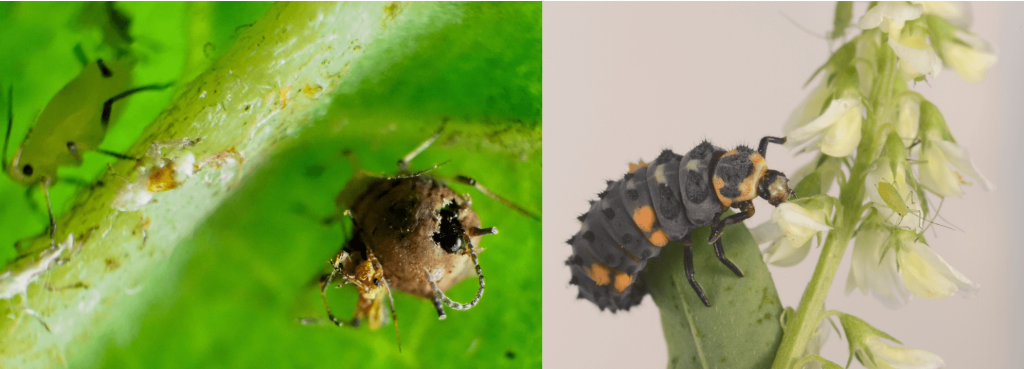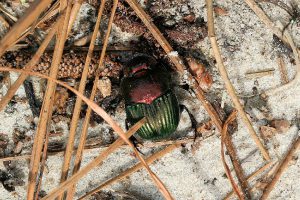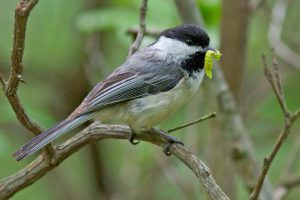
When we think about insects in our yards and gardens, our first thought is probably not about all the many good things they do. But make no mistake, there are far more good bugs than bad bugs which benefit our yards in numerous ways; just that simple understanding can make our lives easier as gardeners.
Insects as pollinators
About 75 percent of flowering plants and 35 percent of the world’s food crops depend on animal pollinators, with the majority being insects. Bees are one of the largest group of pollinators, but many of us only think about the common honeybee, Apis mellifera, an import from Europe. It is true, honeybees can be considered the most important crop pollinator, pollinating over 100 different fruit and vegetable crops. However, native bumble bees, capable of buzz pollination, are much more efficient pollinators of crops like tomatoes, blueberries, and peppers. In fact, there are over 4,000 species of bees native to the United States, with 320 in Florida. Butterflies and moths are also important pollinators in natural ecosystems and managed landscapes and highly attractive to the home gardener. Other insect pollinators include beetles, ants, and flies.

Insects as predators and parasitoids
Many insects consume other insects, especially those we consider pests in the landscape like aphids, mealybugs, whiteflies, thrips, and scale. For example, lady beetles are highly effective predators at the adult and larval stage. There are over 100 different lady beetle species in Florida, 75 specifically feed on scale insects, 13 species feed primarily on aphids, and 4 species seem to specialize as predators of whiteflies. While “ladybugs” are widely available for purchase as biological control, what may be more effective is creating a welcoming environment in home yards and gardens by increasing the variety of plants, especially natives, and allowing some insect pests to live, so they attract the beneficial bugs that feed on them. No one is going to come to a dinner party when there’s no food! This is often referred to as establishing a threshold of damage that is aesthetically acceptable. Other equally important garden predators are lacewings, assassin bugs, ground beetles, praying mantids, spiders (though not actually insects), and even tiny parasitic wasps and flies.

Insects as recyclers

Some insects play key roles in nutrient recycling by feeding on decaying plant and animal material. As insects help break down this organic matter, it is then fed upon by smaller microorganisms within the soil. The result is minerals and nutrients that are now in available forms for plant nutrition, reducing the need for chemical fertilizers and other additives. For instance, dung beetles, in the family Scarabaeidae, are extremely important in cattle pasture ecosystems for their waste removal services, however, they also help reduce nitrogen runoff into waterbodies, greenhouse gas emission, and pest fly populations due to habitat removal. A study published in 2006 estimated the economic value of ecological services provided by insects to be $57 billion. This was based on dung burial, pest control, pollination, and wildlife nutrition.
Insects for wildlife nutrition

Finally, insects are vital food sources for other organisms. Insects are extremely nutritious and unless we are willing to tolerate the occasional caterpillar feeding on our fig trees or grasshoppers nibbling on our grasses, our yards will not be able to attract wildlife, especially birds, with regular frequency. About 96 percent of bird species rely on insects at some point in their life cycle for nutrition, especially for feeding their young. Insect herbivores, those that eat our plants, pass the energy captured by plants to other levels of the food chain and help maintain a balance in the ecosystems they thrive. As Doug Tallamy said, “A plant that has fed nothing has not done its job.”
Photo banner:
Lyside butterfly, Kricogonia lyside. credit M. Leonard-Mularz, UF/IFAS
Skimmer dragonfly, genus Orthemis. credit: T. Raum, MGV
Braconid wasp cocoons on hornworm caterpillar. credit: Adobe stock images
Ladybug larva, Coccinella septempunctata. credit: L. Buss, UF/IFAS
Additional resources:
Insects and pollinators: https://www.nrcs.usda.gov/wps/portal/nrcs/main/national/plantsanimals/pollinate/
Bees of Florida: https://edis.ifas.ufl.edu/pdf%5CIN%5CIN128500.pdf
Pests and pollinators: https://www.nature.com/scitable/knowledge/library/pests-and-pollinators-23564436/
Lady beetles of Florida: https://edis.ifas.ufl.edu/pdf/IN/IN32700.pdf
Managing Dung Beetles to Enhance Cattle Production: https://nwdistrict.ifas.ufl.edu/phag/2018/03/16/managing-dung-beetles-to-enhance-cattle-production/
Biodiversity for the birds: https://www.udel.edu/udaily/2018/october/non-native-plants-birds-insects-washington-chickadee-desiree-narango-doug-tallamy/
 0
0

Comments are closed.